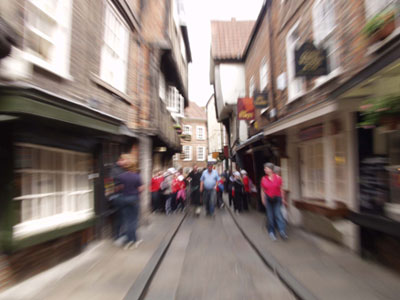The Shambles, York UK
Welcome to the Official Shambles website. Shambles (or The Shambles as it is often referred to) is a street in the city centre of York with a long and interesting past...

Today the Shambles is Europe's most visited street, attracting tourist, shoppers and business clients. We are proud to present this website which brings together the history, community and services of Shambles, York YO1 7LZ.
History
Shambles (also known as 'The Shambles') is a bustling centre piece of historic York. The street today is one of the UK's most visited and has become a wealth of shopping, tourist attractions, restaurants and many other things to see and do, including tours, ghost walks and historic talks. If you want to know York, you need to know Shambles.
The way that fifteenth century buildings lean into the middle of the cobbled street means that the roofs almost touch in the middle. Mentioned in the Domesday book (making it date over 900 years), we know Shambles to be York 's oldest street, and Europe's best preserved Medieval street. It really is a very special place.
The word Shambles originates from the Medieval word Shamel, which meant booth or bench. It was once also referred to as Flesshammel, a word with meaning around flesh; this is because Shambles was historically a street of butchers shops and houses. Records state that in1872 there were 26 butchers on the street. The last butcher to trade on Shambles was at number 27 of the name Dewhurst.
Livestock was slaughtered on Shambles also, the meat was served over what are now the shop window bottoms, and these were originally the Shamels.
It
is also interesting to notice the way the pavements on either side of
the street are raised up, this was done to create a channel which the
butchers would wash away their waste through; offal and blood would
gush down Shambles twice weekly.
Half way along Shambles is the Shrine to Margaret Clitherow, wrongly thought to be her house (the real house is now thought to be 10 Shambles), the council bought this building and made a shrine. See below for more information on Margaret Clitherow.
St. Margaret Clitherow
A butcher’s wife who lived in this famous street, she was brought up in the reformed religion, to which her husband also conformed (they were married in 1571). In 1574, however, she was reconciled to the Catholic church and allowed her house to be used for the shelter of priests and as lodging for a Catholic schoolteacher for her own children and those of neighbours. She kept this up for twelve years, during which time she was arrested on several occasions and spent a total of three years in prison. Eventually her house was searched, and, under threat, one of the pupils revealed where the Mass vestments were hidden. She refused to plead at her trial, wishing, she said, to spare the jury’s conscience; the penalty for this refusal was to be pressed naked beneath a heavy stone and left for three days without proper food or drink. The sentence was not fully applied, but she was crushed to death under a weight at the Tollbooth on the Ouse Bridge in York on the feast of the Annunciation in 1586. Her husband never returned to the Catholic faith, but one daughter became a nun, at Louvain in the Low Countries.
Read more about Margaret Clitherow here.
Attractions, Shops, Cafes, Restaurants & Other Businesses Located Here
Lily Shambles
York's finest selection of Jewellery...Past Images
Past Images specialise in period costume and contemporary photography, we also offer photo restoration services...Margaret Clitherow Shrine
The Shrine to Saint Margaret Clitherow.Home of Margaret Clitherow
The house that was once home to Margaret Clitherow.York Websites
Specialising in Photography and Accommodation Website Design. Also offer many other design, print and digital services.Showing 1 - 8 of 8 Articles
If you aren't listed but would like to be please contact us for review and we'll do our best to get you listed...


